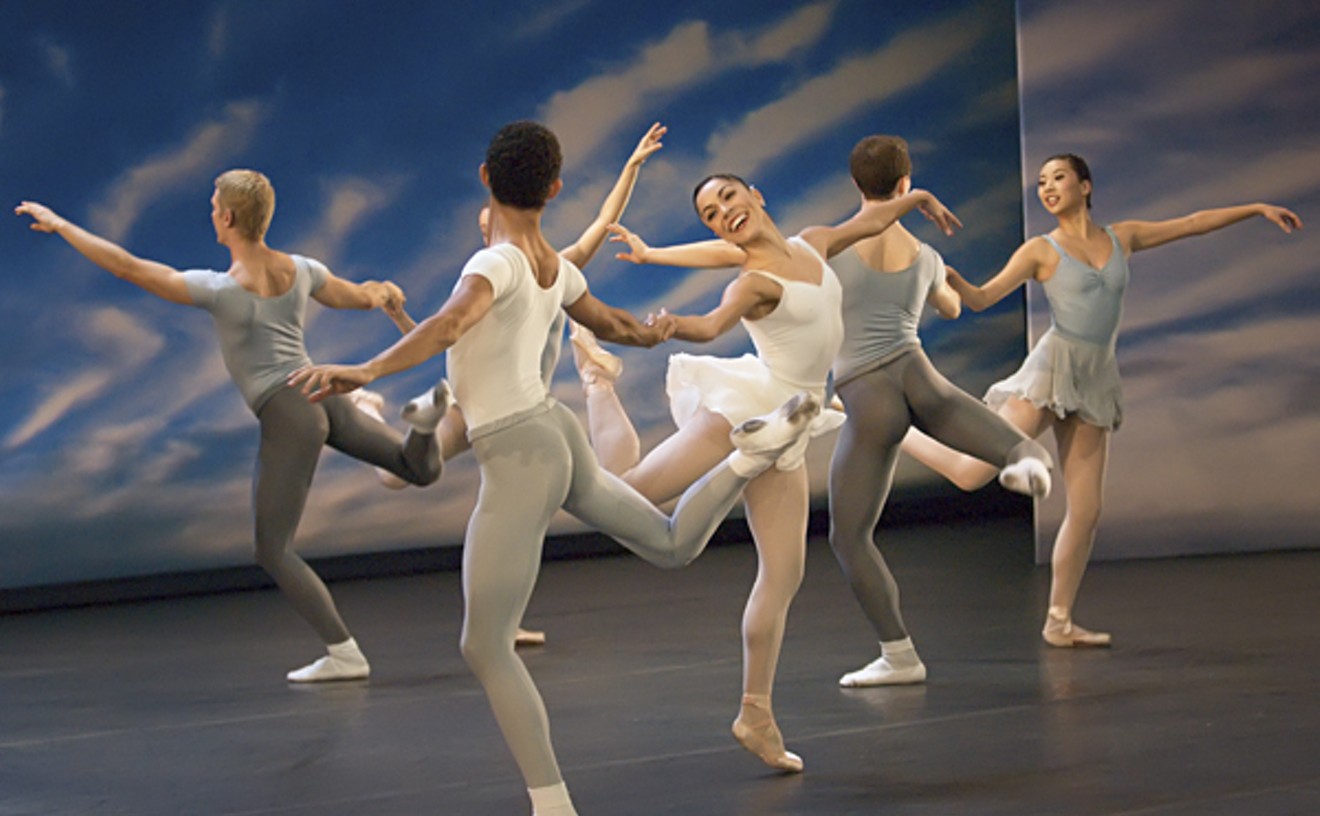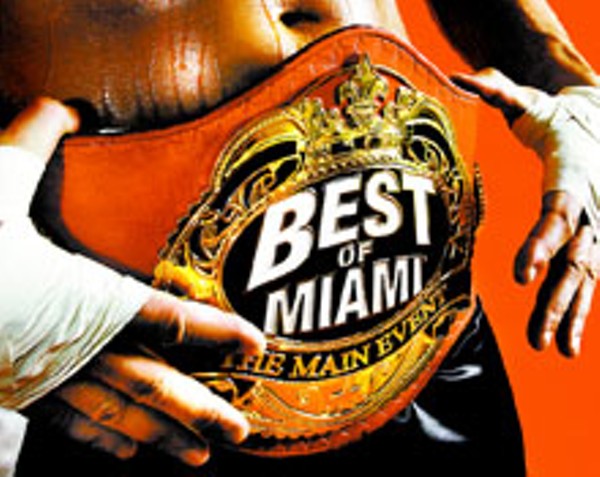Best Dance Company
Miami City Ballet

Miami Beach is known for its beaches, clubs, tycoons, and fashionistas, but it should also be thought of for ballet. The Beach is home to one of the nation's top ballet companies. Magic City balletomanes got lucky in 1986 when dancer Edward Villella became the troupe's founding artistic director. Under Villella's leadership, the little company has grown into a giant: 47 dancers, more than 70 annual performances in South Florida, a thriving ballet school, and a reputation for innovative dance. Classics such as George Balanchine's The Nutcracker and Giselle are regularly performed. But the Miami City Ballet also performs contemporary works by choreographers like Twyla Tharp and Lynne Taylor-Corbett. Beginning this fall, ballet lovers can enjoy pas de deux in the Miami Performing Arts Center. And one of the nicest things for dance lovers is the theater used for the company's contemporary performances: the Lynn and Louis Wolfson II Theatre, an intimate 200-seat space in Miami Beach where no view is a bad one. Individual ticket prices range from $19.95 to $105.
- 2200 Liberty Ave., Miami Beach, 33139 Map
- 305-929-7000
- www.miamicityballet.org
Best Local Icon Gone to Heaven
Burdines Sunshine Fashions
When the last Burdines sign came down a few months ago, more than just a trademark disappeared from the Miami landscape; a homegrown and nationally admired institution faded into the Magic City sunset. Burdines began as a little outpost selling its wares to railroad workers, soldiers headed to war in Cuba, and a small but ethnically diverse population. Both city and store grew rapidly in the tropical warmth. As Miami became a world-class tourist destination, Burdines grew to cater to visitors as well. By the Thirties, the company began producing its own line of clothing that became the rage in colder climes. Those ice freaks, it seems, wanted a little imported sunshine.
Best Day Trip
Key Largo
Fort Lauderdale? West Palm Beach? Close enough, but please. Naples? Nice, but too far. Bimini -- great. But if you don't have a speedy 60-foot power boat, fuhgeddaboutit. Miami, unlike a lot of places on the east or west coasts, does not have loads of quick, nearby escapes to the mountains that can be tackled reasonably in a day. But one 90-minute escape from the Magic City is Key Largo. Of course, a trip to Key Largo is warranted because it's a recreator's paradise -- snorkeling at Pennekamp, fishing in the flats, canoeing and kayaking through the maze of mangroves. But the primary reason Key Largo is the our escape du jour is because it's different. Even the passage to Key Largo is semiexotic. Cross Jewfish Creek or Card Sound, enter the murky never-world of the Everglades, and you're away. Once in Key Largo, with its kitschy shell shops, sportfishermen, seafood restaurants, and drink-your-sorrows-away attitude, you're on vacation. A sun-baked day on the water, enhanced by a few stiff drinkies and then wrapped up with a conch fritter at Alabama Jack's, is a true getaway.
Best New Building
Espiritu Santo Plaza
The 36-story concave space-egg-meets-Saint Louis Arch shape of this building's façade makes it stand out in a downtown of surprisingly unimaginative buildings. Completed in 2004 by the renowned architecture firm Kohn, Pedersen, and Fox, the Espiritu Santo is an elegant building of fascinating geometry. A sculpted walking bridge brings visitors over curbfront pools to the entry, where a restrained marble entry area leads to a second floor atrium featuring a reflecting pool and a dramatic glass ceiling that seems to float eleven stories above. Although it sustained quite a bit of damage during Hurricane Wilma, the Espiritu Santo should be around for a while, holding its place among the signature buildings of Miami's skyline.
Best Director
Ricky J. Martinez
His work has spanned the centuries this season, from assisting Rafael de Acha in the ambitious Shakespeare Project to taking the reins of new plays like Day of Reckoning and Madagascar. He is as fearless as he is generous, making the most of whatever is on the page and letting his actors find their often-surprising best. Martinez watches their back: No one looks bad onstage when this man is in charge, and his choices in everything from the subtlest gestures to the broadest strokes resonate with the feeling of truth.
Best New Condo
Blue
Although we could never afford to live there, Blue is by far the most beautiful condo to sprout on the Biscayne Corridor. It is a striking addition to Miami's changing skyline, standing tall along Biscayne Bay, right at the foot of the Julia Tuttle Causeway. The seductive curve of the north-facing façade is an arching sail of blue-tinted hurricane-proof glass that marries water to sky. And the clean white lines of its bowed back cradle an elevated garden and yoga terrace, pool deck, and fitness center -- all of which sit upon the cleverly concealed parking garage. Inside, floor-to-ceiling windows provide residents with unobstructed panoramic views of the sparkling waters of the bay and ocean. The architecture and design team responsible for creating this masterpiece include Bernardo Fort Brescia, Laurinda Spear, Sergio Bakas, John Jenkins, Victor H. Rodriguez, William Lai, and Ulises Peinado of Arquitectonica, the same firm that designed the American Airlines Arena, the Miami City Ballet headquarters, and the new U.S. Federal Courthouse.
Best Dolphins Player
Zach Thomas
At five feet eleven inches and 228 pounds, Zach Thomas was an unheralded player from Texas Tech University when the Fins drafted him in 1996. Football pundits thought he was too small to play middle linebacker, a position that requires banging heads with 300-pound offensive linemen on a weekly basis. But that didn't stop former head coach Jimmy Johnson from taking a chance on the human wrecking ball from Pampas, Texas. Entering his ninth season, Thomas has proven himself as one of the toughest hombres to don the uniform of Miami's storied football franchise. For the second year in a row, and for the eighth time in his career, he led the team in tackles (166) this past season despite missing games because of injuries. During a loss to the Cleveland Browns this past November, Thomas recorded five tackles while playing with a separated shoulder. His performance earned him his sixth election to the Pro Bowl.
Best Local Landmark
The Wagner Homestead
Tucked away in a patch of urban green is a tangible reminder of Miami's humble roots. Built in 1857, it's the oldest house in Miami-Dade -- a rambling cross between Little House on the Prairie and an Alabama shotgun shack. William Wagner was a white pioneer who settled here as the Seminole wars raged. He built the area's first postcolonial church, ran a mill nearby, married a Creole woman, and watched Miami grow from a malarial outpost to a real town. The house is so charmingly out-of-place you can't help but like it.
Best Drag Queen
Shelley Novak
When the book about South Beach in the gay Nineties is finally written (and what a story it will be), there most certainly should be a chapter dedicated to the one and only Shelley Novak. The hirsute, zaftig drag queen has been hosting her Shelley Novak Awards for the past eleven years. Eleven years! "And I've been doing drag for fifteen years. I don't think anybody I know has made that kind of commitment to anything! I know marriages that haven't lasted that long," quips the blunt-spoken Bostonian. Her awards ceremony is always ribald and ridiculous, fluffy and fun, with a couple of outrageous musical performances tossed in for flavor. "If anything, it becomes like a Friars Club Roast, but it does get taken very seriously. I try to nominate people who I know will get up onstage and break down in tears," chuckles Novak. Besides hosting South Beach's longest-lasting awards ceremony for drag queens, Shelley takes part in the education of the gay community by hosting her own monthly film-screening series, Shelley Novak's Hollywood. Before she stepped into the dazzling spotlight at crobar to hand out awards this year, Novak stood in the darkness of the Miami Beach Cinematheque, to host a suitably reverent tribute to her recently deceased namesake, Shelley Winters. Winters and Novak shared more than a first name. Both were talented yet overlooked for their more svelte and glamorous counterparts. And it's because of actresses like Shelley Winters -- and her other namesake, Kim Novak -- that Shelley Novak continues to proudly carry a torch for almost-forgotten film stars. "The reason I do Shelley Novak's Hollywood is because there was a generation lost," the adorable, self-depreciating cross-dresser reveals. "When I was a young gay kid in 1985, I had all these older gay guys introducing me to John Waters and David Lynch, and because of AIDS, that generation died. For the kids now, there's nobody to look up to for advice, or to teach them old Hollywood, or camp value, or what books to read," she explains. Novak does her part to keep the drag flame burning, welcoming young queens into the circle while simultaneously recognizing the courage and longevity of old warhorses like Henrietta, who's been dressing up since the Fifties. Always an awarder and almost never an awardee, this playfully modest South Beach institution maybe should just write a book of her own.
Best Hidden Neighborhood
Buena Vista
During the Twenties, farmers and other locals who made fortunes in the land boom built this verdant, vibrant neighborhood, sparing no expense on architecture. The houses remain -- framed by NE Second Avenue, NW Sixth Avenue/I-95, the Design District, and Little Haiti -- with all of their chimneys, porticos, balustrades, alcoves, wrought-iron fences, cement fences, wrought-iron-and-cement fences, and plenty of other tasteful and fascinating ornamentation. A couple of decades ago, the area became a magnet for immigrants -- some of the larger homes were converted into rooming houses. The future looked dim for historic preservation, but as sometimes happens in such circumstances, the new arrivals rebuilt Buena Vista, creating a neighborhood with the emphasis on neighbor. Trees abound, lawns are mown and hedges trimmed, people ride bikes and kids play outside. East Buena Vista (the portion between North Miami Avenue and NE Second Avenue) tends to be a bit more upscale, but the entire residential respite from the nearby commercial and cultural chaos is remarkably pleasant and peaceful. The folks in Buena Vista clearly have faith in the future, which is the most important thing for any neighborhood.





